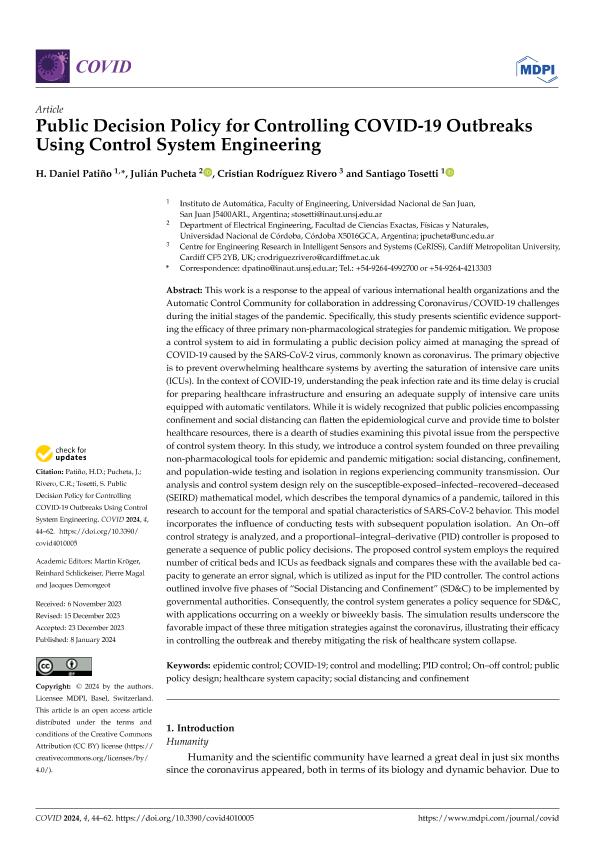Artículo
Public Decision Policy for Controlling COVID-19 Outbreaks Using Control System Engineering
Patiño, Héctor Daniel; Pucheta, Julián Antonio ; Rivero, Cristian Rodríguez; Tosetti Sanz, Santiago Ramon
; Rivero, Cristian Rodríguez; Tosetti Sanz, Santiago Ramon
 ; Rivero, Cristian Rodríguez; Tosetti Sanz, Santiago Ramon
; Rivero, Cristian Rodríguez; Tosetti Sanz, Santiago Ramon
Fecha de publicación:
12/2023
Editorial:
MDPI
Revista:
COVID
ISSN:
2673-8112
Idioma:
Inglés
Tipo de recurso:
Artículo publicado
Clasificación temática:
Resumen
This work is a response to the appeal of various international health organizations and the Automatic Control Community for collaboration in addressing Coronavirus/COVID-19 challenges during the initial stages of the pandemic. Specifically, this study presents scientific evidence supporting the efficacy of three primary non-pharmacological strategies for pandemic mitigation. We propose a control system to aid in formulating a public decision policy aimed at managing the spread of COVID-19 caused by the SARS-CoV-2 virus, commonly known as coronavirus. The primary objective is to prevent overwhelming healthcare systems by averting the saturation of intensive care units (ICUs). In the context of COVID-19, understanding the peak infection rate and its time delay is crucial for preparing healthcare infrastructure and ensuring an adequate supply of intensive care units equipped with automatic ventilators. While it is widely recognized that public policies encompassing confinement and social distancing can flatten the epidemiological curve and provide time to bolster healthcare resources, there is a dearth of studies examining this pivotal issue from the perspective of control system theory. In this study, we introduce a control system founded on three prevailing non-pharmacological tools for epidemic and pandemic mitigation: social distancing, confinement, and population-wide testing and isolation in regions experiencing community transmission. Our analysis and control system design rely on the susceptible-exposed?infected?recovered?deceased (SEIRD) mathematical model, which describes the temporal dynamics of a pandemic, tailored in this research to account for the temporal and spatial characteristics of SARS-CoV-2 behavior. This model incorporates the influence of conducting tests with subsequent population isolation. An On?off control strategy is analyzed, and a proportional?integral?derivative (PID) controller is proposed to generate a sequence of public policy decisions. The proposed control system employs the required number of critical beds and ICUs as feedback signals and compares these with the available bed capacity to generate an error signal, which is utilized as input for the PID controller. The control actions outlined involve five phases of ?Social Distancing and Confinement? (SD&C) to be implemented by governmental authorities. Consequently, the control system generates a policy sequence for SD&C, with applications occurring on a weekly or biweekly basis. The simulation results underscore the favorable impact of these three mitigation strategies against the coronavirus, illustrating their efficacy in controlling the outbreak and thereby mitigating the risk of healthcare system collapse.
Archivos asociados
Licencia
Identificadores
Colecciones
Articulos(INAUT)
Articulos de INSTITUTO DE AUTOMATICA
Articulos de INSTITUTO DE AUTOMATICA
Citación
Patiño, Héctor Daniel; Pucheta, Julián Antonio; Rivero, Cristian Rodríguez; Tosetti Sanz, Santiago Ramon; Public Decision Policy for Controlling COVID-19 Outbreaks Using Control System Engineering; MDPI ; COVID; 4; 12-2023; 44-62
Compartir
Altmétricas
Items relacionados
Mostrando titulos relacionados por título, autor y tema.
-
Belcic, Sofía (Universidade Federal Fluminense, 2020-12)
-
Alvites Baiadera, Angélica Paola ; Joiko, Sara; Collazos, Milena (Universidad Complutense de Madrid, 2023-06)
-
Montoya Giraldo, Oscar Danilo; Gil González, Walter; Serra, Federico Martin (Universidad Industrial de Santander, 2020-09)



